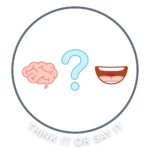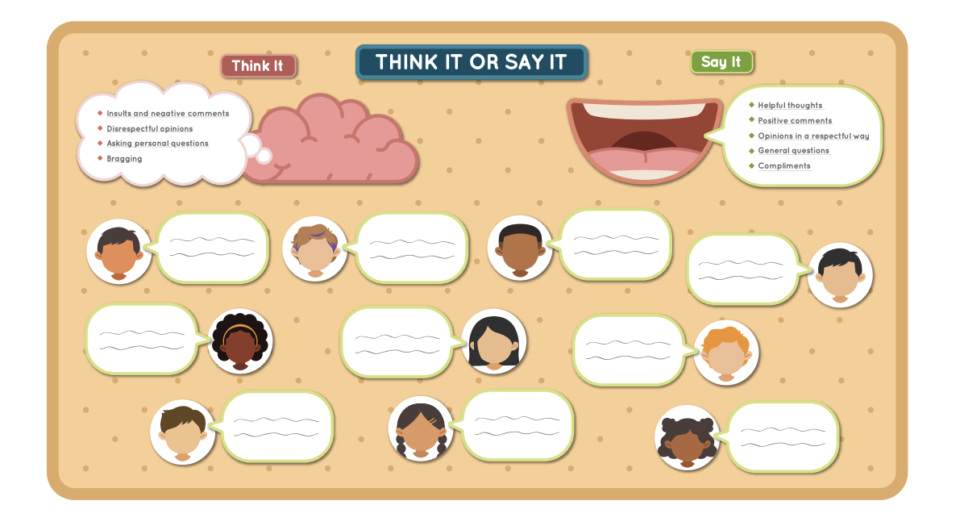
Teaching middle schoolers the difference between thoughts they should keep to themselves and statements they should say out loud is crucial for their social and communication skills. The “Think It or Say It” concept helps students navigate social interactions more effectively. An engaging bulletin board for speech-language pathologists from Everyday Speech can help to illustrate this concept in a visually appealing way. This blog post will guide you through creating and using this bulletin board to enhance your students’ understanding of “Think It or Say It.”
Why “Think It or Say It” Matters
Understanding the difference between thoughts and appropriate verbal expressions is important because:
- Improves Social Skills: Helps students interact more appropriately with peers and adults.
- Enhances Communication: Encourages clear and considerate communication.
- Builds Self-Regulation: Teaches students to control impulsive thoughts and behaviors.
- Promotes Empathy: Fosters an awareness of how words can affect others.
Introducing the “Think It or Say It” Bulletin Board
The “Think It or Say It” bulletin board bundle from Everyday Speech provides a visually engaging and interactive way to teach this concept. The bundle includes ready-to-cut pages, labels, and speech bubbles that make it easy to create a dynamic bulletin board. By incorporating students’ photos and their examples of appropriate speech, the bulletin board becomes a personalized and powerful learning tool.

Instructions for Creating the Bulletin Board
Materials Needed
- Everyday Speech “Think It or Say It” bulletin board bundle
- Scissors
- Glue or tape
- Bulletin board
- Photos of students (10 x 10 cm)
- Markers or pens
- Printer
Duration
60 minutes
Activity Steps
1. Prepare the Bulletin Board Pieces (10 minutes)
Print out the pages from the bulletin board bundle. This includes the title, Think It (Brain), Say It (Mouth), and the Think It & Say It labels and bubbles pages. Carefully cut out each piece.
2. Take and Print Student Photos (10 minutes)
Take photos of your students looking contemplative. Print these images using the photo sizing guide provided (10 x 10 cm).
3. Create Speech Bubbles (20 minutes)
Have each student write down an example of one “Say It” phrase on a speech bubble. These should be phrases that are appropriate to say out loud in a social context.
4. Assemble the Pieces (20 minutes)
Cut out all the speech bubble pieces along with the students’ photos. Arrange and attach these pieces onto your bulletin board according to the instructions provided.
5. Discuss and Reflect (10-20 minutes)
After assembling the bulletin board, have a discussion with your students about the different examples they provided. Use this opportunity to reinforce the concepts and encourage further reflection on when it’s appropriate to say something out loud or keep it as a thought.
Tips for Success
1. Make It Interactive
Encourage students to interact with the bulletin board by adding new examples of “Think It” and “Say It” phrases regularly. This keeps the board dynamic and engaging.
2. Personalize the Experience
Including students’ photos and personal examples makes the bulletin board more relatable and impactful. It helps students see themselves in the learning process.
3. Use Visual Aids
Utilize the visually engaging elements of the bulletin board to reinforce learning. The brain and mouth images serve as clear, memorable cues for students.
4. Reinforce Through Practice
Incorporate the “Think It or Say It” concept into daily activities and discussions. Reinforcement through practice helps solidify the learning.
Unlock our full Pre-K through 12th Grade curriculum by signing up for your free trial today – no credit card required!
Access the full Social Communication Curriculum HERE!
Instant access to thousands of no-prep social skills activities, over 1000+ video lessons, and engaging games designed to enhance learning and development.
Conclusion
Helping middle school students understand the difference between thoughts they should keep to themselves and statements they should say out loud is a vital skill. Using this engaging bulletin board for speech-language pathologists provides an engaging and effective way to teach this concept. By following the step-by-step instructions and incorporating the no-prep activity ideas, educators can create a comprehensive and interactive learning experience. For more resources on supporting students’ social-emotional learning, stay tuned to our blog.
Sample Video
Try out this sample animated video lesson.
We offer our entire Social-Emotional Learning platform free for 14 days here!
Related Blog Posts:
Navigating Middle School: Enhancing Social Skills Through Videos
Teaching Middle School Students to Stay Calm and Solve Problems
Promoting Mental Well-being: SEL Lessons for Middle School Students





